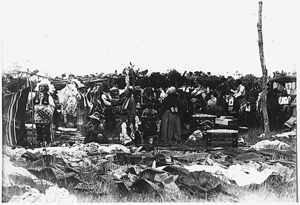Potawatomi people facts for kids
| Bodéwadmi | |
|---|---|

Potawatomi at a rain dance in 1920
|
|
| Total population | |
| 28,000 | |
| Regions with significant populations | |
| Languages | |
| English, Potawatomi | |
| Religion | |
| Catholicism, Methodism, Midewiwin |
The Potawatomi are a group of Native Americans who traditionally lived in the Great Plains, near the upper Mississippi River, and around the western Great Lakes region. They are also known as Pottawatomi or Pottawatomie.
The Potawatomi people traditionally speak the Potawatomi language. This language is part of the larger Algonquian language family. The Potawatomi call themselves Neshnabé, which means "original people" or "true people." This name is similar to Anishinaabe, a name used by many related groups.
The Potawatomi are part of a special, long-lasting friendship called the Council of Three Fires. This alliance includes the Ojibwe and Odawa (Ottawa) peoples. In this alliance, the Potawatomi were seen as the "youngest brother." They were also called Bodéwadmi, which means "keepers of the fire." This name refers to their important role in keeping the council fire burning for all three groups.
Potawatomi History
In the 1800s, the Potawatomi people faced big changes. More and more European and American settlers moved into their lands around the Great Lakes. Because of this, the Potawatomi were asked to move west.
Many Potawatomi families had to leave their traditional homes. They moved to new lands, often called reservations, in places like Nebraska, Kansas, and what is now Oklahoma. This movement was part of a government plan called Indian Removal. However, some Potawatomi groups managed to stay in the Great Lakes region. Today, these groups are officially recognized as tribes by the government. In Canada, there are also more than 20 Potawatomi groups, known as First Nation bands.
Images for kids
-
Metea lithograph (1842)
-
Rain dance, Kansas, c. 1920
See also
 In Spanish: Potawatomi para niños
In Spanish: Potawatomi para niños







